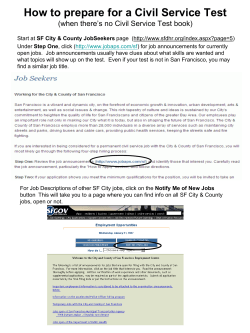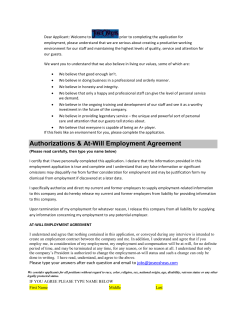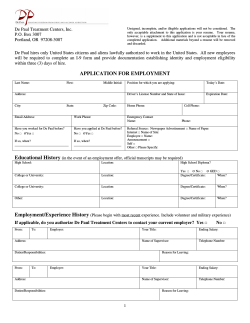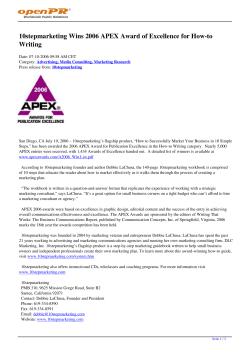
How to Write Effective Job Descriptions What is a Job Description?
How to Write Effective Job Descriptions The Basics of a Job Description What is a Job Description? A job description is a written statement that describes the main objective of a job, its essential and nonessential functions, the qualifications and skill set the position requires. A job description may describe duties, skills, effort, and responsibilities, environmental and working conditions, environment, education and experience required. It also may include information on tools and equipment, internal and external relationships with other jobs and people. Fifty people may hold the same job and, therefore, use the same job description. It is important to remember that a job description describes the job, not the person or persons who hold that job position. Specific or Generic? A Specific Job Description will provide information on all of the essential duties, responsibilities, education and skills assigned to one or more individuals performing the job function. It is usually detailed and comprehensive and provides a solid foundation for job evaluation, training, orientation, and human resource and organizational planning. This type of job description demands a thorough job analysis, considerable care and expertise in preparation, and an effort to keep it effective, informative and up to date. It is the soundest type of job description to use, and usually the most expensive to prepare. There is also an inclination to exclude secondary responsibilities and duties, and disagreements an arise between a supervisor and employee when relatively minor job duties change. Communication between the two parties is a must and mutual agreement for sign-off is required if you do not want to be put in this situation. Generic Job Descriptions, alternatively, are written in general terms without identifying specific functions, responsibilities, duties or accountability statements. A generic description is applicable to a group of similar or near-similar jobs, and therefore the per-job cost of preparation is lower. However, since the description must be written broadly enough to allow for some variations in product, materials, procedures or equipment and it may include some functions performed in one or more of the jobs but not all of them. An important aspect of the job description and how it should be viewed is to understand that it should not be viewed as a perfect reflection of the job. The point of a good job description is to make a distinction from other jobs or groups of job families and to set outer limits. The information for much of the job description often is obtained by conducting a job analysis. The purpose is to identify the job, define it within established parameters, and describe its scope and content. The job analysis should be accurate, concise, and complete. The design of the questions for this should be a combination of closed and open. Job descriptions, and the process and procedure used to develop them, should conform to all employment legal requirements. If you are unsure of your laws in your area, you should contact your Human Resource Associate within your state or province. Again, while the law does not specifically require the use of job descriptions (private companies), it has great ramifications on their use. PHR RESOURCES LTD. | T. 604 340 2959 | E. info@phrresources.com All material by Debbie Bortolussi www.phrresources.com Copyright Debbie Bortolussi © How to Write Effective Job Descriptions The Basics of a Job Description Why are Job Descriptions Important? “I’ve never run into anyone who has admitted liking to write job descriptions”. However these tools are critical to effective and legal human resource administration. • I use job descriptions for driving recruitment campaigns, setting expectations for new job candidates, establishing salary grade levels for job families/groups of jobs, and align individual goals and activities with an organization’s strategic objective and mission. So Many Jobs, So Little Time: Benefit or a Curse Job Descriptions are important for a number of reasons: • Precise job descriptions provide a bases for job evaluation, wage and salary surveys, and an equitable wage and salary structure for your organization and your team members. • Job descriptions help management analyze and improve the company’s structure. They reveal whether all company responsibilities are adequately covered and where these responsibilities should be reallocated to achieve a better balance. • Job descriptions are valuable to applicants, employees, supervisors, and human resource professionals at early stage in the employment relationship, from the recruitment campaign to retirement. They provide information about the knowledge, skills, education and potential training required for each job. They are a communication tool to internal candidates and external candidates and prevent misunderstandings by telling employees what they need to know about their jobs and careers. I have had candidates apply for positions and once I go through it with them line by line…. they decide this is not quite what they were looking for. So the job description becomes a great tool for screening potential candidates during the telephone interview process. The job description helps the candidate understand the responsibilities and accountabilities of the position and where the job fits into the company and their team as a whole. Despite these and other benefits, job descriptions traditionally have suffered a poor reputation among managers and human resource professionals. In fact, job descriptions often end up being ignored. “Job descriptions? Sure, we have them. They’re in the bottom drawer of that file cabinet with the big stack of books in front of it. Why? There are a number of reasons. It takes commitment to develop and maintain job descriptions. It means that someone must champion that responsibility and be accountable. It must be part of someone’s mandate in the organization. In addition, it takes buy in from the Senior Management team, supervisors and team members to take time to participate in maintaining the process. It really needs to be part of the “best practice road map” and continuous improvement methodology. There is a tendency to put job descriptions in the back burner of our day to day activities until the crisis call happens. PHR RESOURCES LTD. | T. 604 340 2959 | E. info@phrresources.com All material by Debbie Bortolussi www.phrresources.com Copyright Debbie Bortolussi © How to Write Effective Job Descriptions The Basics of a Job Description Case: The new person is hired and is not performing their job as well as their predecessor. Their supervisor does not understand why. In most of these cases I have seen the person was hired under the old job description and the predecessor had taken that job and their role had expanded over the years and that job was never re-classified. So now it is a crisis situation, and it takes a lot more effort to set up meetings to find out whether the problem is a performance concern, a personality conflict between the supervisor and the new hire, or simply poor communication during the hiring process. Accurate, Precise, Correct = Validity which earns Credibility of the “Job Description” I think this is a major milestone in any company. Yet, we see that one of the most common factors that a job description isn’t used is because it isn’t useful because it is out of date. Therefore it lacks validity, and it fails to achieve its real purpose. The job description is a valid tool only to the extent that it can accurately reflect the job duties, qualifications and skills required in today’s market. An out of date job description obviously is not accurate or valid and has no credibility in or out of the organization. I always suggest conducting a job analysis on an annual basis with the person holding the job. This should help with validity problems. This process does not have to be complex as you can just have a simple discussion with the team member holding the job or ask them to complete a simple job analysis questionnaire. The accountability lies with the direct supervisor/manager who is responsible for that job function. The Meter Starts Running On Day One Don’t try to remake the world overnight, but keep in mind the meter starts running on day one when your new team member joins you and is trying desperately to prove their worth. If the job description you have in your hand fails to accurately reflect the job, consider some of the possible consequences. Candidates without the proper qualifications may be referred to department managers for hiring or promotion; these positions many be ranked for compensation improperly with others in terms of their worth to the organization and external job market; and team members may end up struggling to achieve unrealistic standards of performance ….. The typical job description is often deficient in at least one of the following ways: 1. 2. 3. 4. 5. I see job descriptions that are canned job descriptions – there is no spirit or company feeling in it. The description embellishes on the duties or often downplays the importance of the position to the organization. It ignores the accountability of the position. Often the requirements or characteristics that are set out are not really needed to succeed in the job. In particular, many job descriptions fail to answer some of the most basic questions a candidate needs to know to perform the job. Suppose that you are a newly hired Information Technology Manager – Would you have enough information about the new job to feel confident about what was expected of you and what about your ability to meet the job’s performance goals, objectives and standards? PHR RESOURCES LTD. | T. 604 340 2959 | E. info@phrresources.com All material by Debbie Bortolussi www.phrresources.com Copyright Debbie Bortolussi ©
© Copyright 2025












